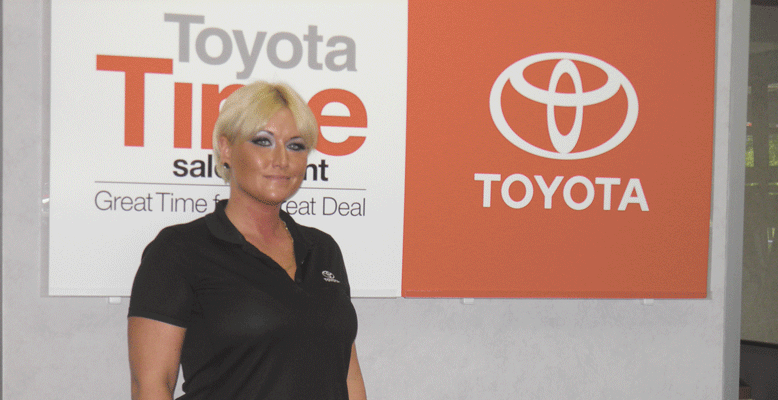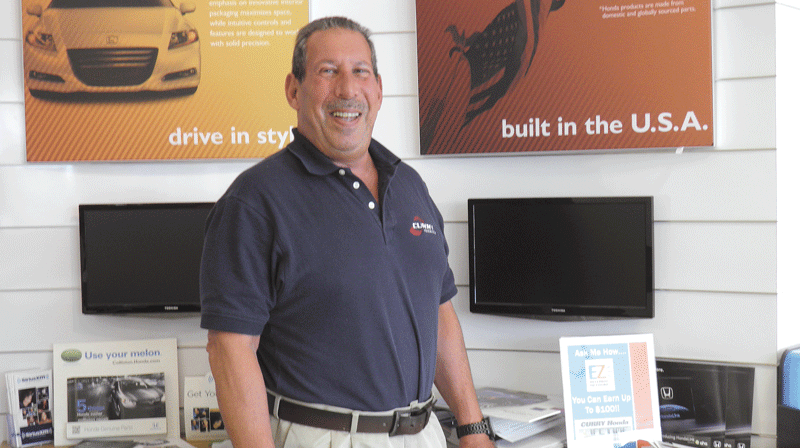Negligible Negotiations
Information Technology Changes the Way Vehicles Are Sold

Sara Holmes says leasing vehicles comprises half the new-car business at Lia Toyota Scion of Wilbraham.
“Ten years ago, when people came into a showroom, the starting place for negotiations was the window sticker, and the whole process could take several hours. Today, an entire negotiation can be completed in about 20 minutes because people know what they want and how they want to pay for it,” said Holmes, general manager of Lia Toyota Scion of Wilbraham, adding that 80% of sales there are Internet-driven.
Howard Sackaroff agrees. “Years ago, most new-car sales were almost impulse buys. But today, people plan for a purchase and do a lot of research before they even visit a dealer,” said the general manager of Curry Honda and Curry Nissan in Chicopee. “They check safety, fuel economy, and reliability, and sites such as Edmunds or Kelley Blue Book not only provide them with invoices and suggest the amount they should expect to pay, they also give them the value of their trade-in. So by the time consumers show up, they have already made a decision, which makes the process much smoother.”
The trend is reflected at other local dealerships, including Bertera Subaru in West Springfield, where General Sales Manager Mark Noel said the majority of people who visit are ready to make a purchase. “They come to the showroom prepared to buy, as opposed to beginning a search,” he said.
Although customers who have never driven a Subaru may return more than once, he added, “they have already shopped at home, decided what best suits their needs, and gotten the pricing out of the way so the process is a lot shorter and less contentious than it used to be.”
Since price ultimately attracts business, aggressive online marketing programs have become a necessity for dealers. There are many different approaches, such as one used by Curry, where people can choose a specific car, then hit a button on a website to reserve it.
“When that happens, they receive a return e-mail with the lowest possible price,” Sackaroff said. “It lists the features and benefits of the vehicle they have chosen, but they also receive five alternative choices that are similar to the vehicle with their lowest price. It takes negotiation out of the equation.”
He noted that he sets prices weekly or bimonthly based on supply and demand, but admits a small bit of “wiggle room” can remain, and on occasion the price is reduced in the showroom by $50 or $100 — “but that’s it.”
Noel agrees. “Dealers have always had to be competitive, but competition has increased due to the Internet,” he said. “So, once a person locates the lowest price online, it is really the best price out there. All that is left is negotiating the cost of service plans and the person’s trade-in.”In fact, Joe Soucy calls the Internet “the equalizer.”
“Manufacturers have bridged the pricing gap between brands, and the days of negotiating a price that is thousands of dollars less than the starting point are gone,” said Soucy, general sales manager for Bob Pion Buick GMC in Chicopee. “Today, people search to find who has the vehicle with the equipment they want at the price they want to pay, and any negotiations that do take place are usually in hundreds of dollars.”
But price isn’t the only consideration. Service also plays into the equation, so local dealers do everything possible to cater to their clients.
“Several weeks ago, a customer was dissatisfied with a new car that developed a transmission problem two weeks after he bought it. In the old days, it would have been repaired under the warranty, but I gave him a new car,” Sackaroff said, adding, “we maintain an advantage based on our reputation and on referrals, so we always try to do the right thing.”
Sales managers concur that excellent customer service is more important than ever before, especially since people who have a bad experience can document it on sites such as Angie’s List and Google, where it can be read by millions of viewers.
“For us,” Holmes said, “it’s about keeping people happy at the end of the day.”
Unrealistic Expectations
Although dealers typically make less than $1,000 on a new car, people still enter showrooms who haven’t done any research, don’t believe how small the profit margin is, and become skeptical when they are told there is no room to negotiate.
“We showed a customer a factory invoice yesterday, but he thought it was phony,” Sackaroff said. “So the salesman had to go online and show him the price of cars on Edmunds.”
Noel has had similar experiences. “People don’t always believe the dealer. But showing them a trusted third-party source makes it so much easier,” he agreed.
According to Soucy, one of the things some customers fail to take into account is that destination prices and preparation work are not included in the invoice. “For example, truck steps are installed upon arrival, and the price of a vehicle can differ according to trim levels. But in some instances, people need to shop at other dealers to find they have reached the end of the negotiating road. “
There is room for negotiation, however, when it comes the buyer’s trade-in. Still, dealers say many people are unrealistic. “Some look up what the vehicle would sell for in the retail market as opposed to its trade-in price. And people tend to believe the information they have gathered themselves as opposed to what a dealer tells them,” Noel said.Holmes agrees. “There are tools online that allow people to play appraiser, and when they get here, they have decided what their car is worth,” she said, adding that emotional attachments can play into the equation. “I have had customers who have named their car. They think, because they love it, it has to be worth more than we tell them.”
Soucy said people also often overestimate their vehicle’s condition. “Everyone thinks their car is in great condition, and that’s what they check off when they visit an Internet pricing site.”
Value also depends on the amount of work a car, SUV, or truck will need before it can be resold. In order for a vehicle to be certified, it must meet stringent requirements, which can include new tires and brakes, in addition to things such as an oil change. “We spend $1,500 on average to certify a car, even if it is very clean when we get it,” Sackaroff said.
Soucy said every discount possible is included in an online price, and the margin of profit is lower on entry-level vehicles than on high-end models. He explained that discounts are what the dealer is allowed to chop off of the manufacturer’s suggested retail price — a figure that is generally lower on cars than on trucks — while rebates are determined by the manufacturer.
“If a model is being closed out, the rebates are usually higher,” he explained. “However, many factors play into discounts and manufacturers’ rebates. And although deals in auto sales are a preconceived notion, people have the belief that a holiday or the end of the year is when they will get the best deal. But that may or may not be true.”
Sackaroff agrees, noting that there is often only $50 to $100 difference in the price, and there may not be much difference in the vehicle other than the model year. “When I was a kid, new cars were always styled differently. But today, styling changes only take place every four to six years.”
In other words, Noel said, “no one has any idea what a manufacturer will offer in six months, so now is always the best time to buy a car.”
Special Conditions
People can save several thousand dollars by purchasing dealer demos, which typically have been driven only 5,000 to 6,000 miles and are registered as new cars with full warranties. “They are generally good buys, as we depreciate their price. Plus, we see many people with Hondas and Nissans that have more than 150,000 miles on them, so an extra 6,000 miles doesn’t make much of a difference when they turn them in,” Sackaroff explained.
Holmes agrees. “Demos are discounted below invoice by $500 to $2,000, depending on how popular the car is,” she said, adding that special pricing is also often available to new college graduates and people serving in the military. “Manufacturers are helping young people get started, so college graduates don’t usually need a co-signer.”
Leasing is another option — one that’s becoming more popular, said Holmes, noting that about half of Lia Toyota Scion’s new cars are leased. “Today, most people are budget-conscious, and leasing helps keep payments low,” she added, explaining that new cars offer the latest safety features along with free maintenance, which typically includes oil changes and tire rotations. In addition, a variety of mileage plans can be factored into the price. “But if you drive 30,000 miles a year, a lease may not be the best option.”
However, Soucy thinks leasing is the best way for most people to acquire a new vehicle. “You are only accountable for payments during the lease period, and the bank takes all of the risk,” he said, recalling that, when gas prices skyrocketed, people who leased could walk away from vehicles that got low mileage. “And if the manufacturer stops making the model, the person who leases it is not responsible for the fact that it is worth less when the lease ends. We sign zero-down leases every day.”
All that said, the Internet remains the most significant reason why the car-buying experience has changed, and local dealers told BusinessWest it has been been a boon to business. “It has expanded our market and allowed us to see more people. We have sold cars to people in Florida, Washington, and California,” Noel said, explaining that most people who travel great distances do so because they want a specific used vehicle, as opposed to a new one.
But showroom managers agree that a dealer’s customer-service reputation can be the deciding factor in where people purchase a vehicle. “People want to buy from salespeople who are knowledgeable and who they feel they can trust,” Holmes said. “It’s all about trust, and when the process is easy, buyers are happier, and we are happier too.”
Sackaroff concurs. “The changes in negotiation have made life easier for me and for my salespeople,” he said. “But you still have to earn your business, and we have earned the trust of the community and the families in it.”







